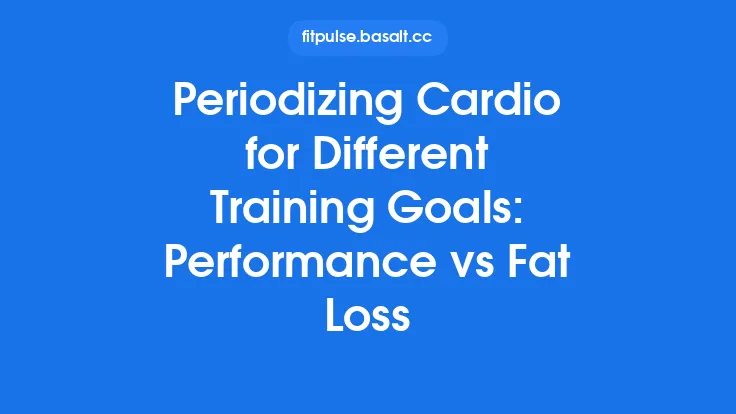Understanding the concept of training phases is essential for anyone who wants to move beyond “just lifting” and toward a systematic, science‑backed approach to performance. Rather than treating every workout as an isolated event, phase planning groups training variables into purposeful blocks that target specific adaptations—whether that’s building a solid anatomical base, increasing muscular size, sharpening neural efficiency, or peaking for a competition. By aligning workouts with the body’s natural adaptation timeline, athletes and recreational lifters alike can achieve more consistent progress, reduce injury risk, and finish each training cycle feeling stronger and more confident.
Why Training Phases Matter
- Biological Timing – The human body does not respond to a single stimulus in a vacuum. Muscular, neural, hormonal, and connective‑tissue systems each have distinct timelines for adaptation. A phase that emphasizes one system (e.g., neural drive) will inevitably influence the others, and planning ensures these influences are constructive rather than contradictory.
- Progressive Overload with Purpose – While the principle of progressive overload is universal, phases give that overload a direction. Instead of merely adding weight each week, a hypertrophy phase will increase volume, a strength phase will raise intensity, and a power phase will focus on velocity. This purposeful overload maximizes the specific quality being targeted.
- Psychological Clarity – Knowing the current focus (e.g., “this is my strength block”) reduces decision fatigue and provides mental motivation. Athletes can set clear, short‑term goals that feed into long‑term aspirations.
- Recovery Management – Different phases impose varying stress on the central nervous system (CNS) and musculoskeletal structures. Structured phase planning allows for systematic periods of reduced CNS demand, which helps prevent chronic fatigue and overtraining.
Core Physiological Adaptations Across Phases
| Phase Type | Primary Adaptation | Typical Training Variables |
|---|---|---|
| Anatomical/General Conditioning | Connective‑tissue resilience, joint stability, basic motor patterns | Low‑to‑moderate intensity, high volume, varied movement patterns, emphasis on technique |
| Hypertrophy (Muscle Size) | Myofibrillar and sarcoplasmic growth, increased capillary density | Moderate intensity (65‑80% 1RM), moderate‑high volume (8‑15 reps, 3‑5 sets), moderate rest (60‑90 s) |
| Strength (Maximal Force) | Neural recruitment, motor unit synchronization, intramuscular coordination | High intensity (80‑95% 1RM), low‑moderate volume (1‑5 reps, 3‑6 sets), longer rest (2‑5 min) |
| Power/Speed | Rate of force development, phosphocreatine system efficiency | Low‑to‑moderate intensity (30‑60% 1RM) performed explosively, low volume, long rest (3‑5 min) |
| Peaking (Performance Peak) | Fine‑tuning of technique, CNS priming, psychological readiness | Very high intensity, very low volume, sport‑specific drills, tapering of overall fatigue |
Understanding these adaptations helps you match the right variables to the right phase, ensuring each block builds on the previous one rather than working at cross‑purposes.
Common Phase Models and Their Characteristics
- Linear Periodization
- Structure: Gradual, stepwise increase in intensity while volume decreases across successive phases.
- Best For: Beginners and intermediate lifters who benefit from clear, predictable progression.
- Undulating (Non‑Linear) Periodization
- Structure: Intensity and volume fluctuate more frequently—daily, weekly, or bi‑weekly—allowing multiple stimulus types within a short timeframe.
- Best For: Athletes needing to maintain multiple qualities (e.g., strength and power) simultaneously, or those with variable competition schedules.
- Block Periodization
- Structure: Distinct “blocks” each dedicated to a primary quality (e.g., accumulation, transmutation, realization). The blocks are often longer (3‑6 weeks) and may overlap slightly to allow residual effects to carry forward.
- Best For: Advanced athletes targeting specific performance peaks, especially in sports with defined competition windows.
- Conjugate (Westside) Model
- Structure: Simultaneous development of multiple qualities within a week (e.g., max effort, dynamic effort, repetition effort).
- Best For: Powerlifters and strength athletes who need to maintain high levels of strength while also improving speed and hypertrophy.
Each model offers a different balance between predictability, flexibility, and specificity. Selecting a model should align with the athlete’s experience level, sport demands, and personal preference for training structure.
Designing Phase Lengths and Overlap
- Typical Duration: Most phases last 3‑6 weeks. Shorter phases (<3 weeks) may not provide enough time for measurable adaptation, while longer phases (>8 weeks) risk diminishing returns and increased injury risk.
- Overlap Strategy: To preserve gains from a preceding phase, a small “overlap” of 1‑2 sessions can be incorporated. For example, during the first week of a strength block, retain a few hypertrophy‑oriented sets to maintain muscle size while the CNS adapts to heavier loads.
- Micro‑Cycle Integration: Within a phase, weekly micro‑cycles can vary slightly (e.g., a “hard” day, a “moderate” day, and a “recovery” day) to manage fatigue without compromising the overall phase goal.
Integrating Load, Volume, and Intensity Within Phases
- Load (Weight or Resistance) – Determines the mechanical stress placed on muscles and CNS. In early phases, load is moderate to promote technique; in later phases, load climbs toward maximal levels.
- Volume (Sets × Reps × Load) – Drives metabolic stress and muscle damage, crucial for hypertrophy. Volume is highest in anatomical and hypertrophy phases and tapered as intensity rises.
- Intensity (Relative Load to 1RM) – Governs neural adaptations. As intensity increases, volume must decrease to keep total stress manageable.
A practical way to visualize this relationship is the “training triangle”: as one corner (e.g., intensity) expands, the opposite corner (e.g., volume) contracts. Maintaining balance prevents overreaching and ensures each phase’s primary adaptation is emphasized.
Monitoring and Adjusting Phase Effectiveness
- Objective Metrics
- Strength Tests: 1RM or 3RM on core lifts every 4‑6 weeks.
- Body Composition: Skinfolds, bioelectrical impedance, or DEXA scans to track hypertrophy.
- Performance Benchmarks: Sprint times, jump height, or sport‑specific drills for power phases.
- Subjective Metrics
- Rate of Perceived Exertion (RPE): Helps gauge CNS fatigue.
- Recovery Questionnaires: Sleep quality, muscle soreness, mood.
- Heart‑Rate Variability (HRV): Offers insight into autonomic balance and readiness.
If metrics indicate stagnation or excessive fatigue, consider adjusting one of the three primary variables (load, volume, intensity) or inserting a brief “maintenance” micro‑cycle that preserves the current adaptation while allowing recovery.
Individual Differences and Customization
No two athletes respond identically to a given phase structure. Factors influencing customization include:
- Training Age – Novices adapt quickly to volume, while seasoned lifters need higher intensity to stimulate further gains.
- Genetic Predisposition – Some individuals are naturally more “fast‑twitch” dominant, responding better to power‑oriented phases.
- Lifestyle Constraints – Work schedules, travel, and family commitments may dictate shorter phases or more flexible micro‑cycles.
- Injury History – Prior injuries may necessitate extended anatomical conditioning or targeted mobility work before progressing to high‑intensity phases.
A practical approach is to start with a generic template (e.g., 4‑week hypertrophy → 3‑week strength → 2‑week power) and then fine‑tune based on the data collected from the monitoring tools above.
Common Mistakes to Avoid When Planning Phases
| Mistake | Why It Undermines Progress | Simple Fix |
|---|---|---|
| Skipping the Anatomical Base | Lacks joint stability and movement proficiency, leading to technique breakdown under heavy loads. | Allocate at least one phase (or a portion of a phase) to fundamental movement patterns and connective‑tissue work. |
| Changing Phase Goals Mid‑Cycle | Confuses the adaptation signal; the body receives mixed messages, slowing progress. | Commit to a phase’s primary objective for its full duration unless objective data forces a change. |
| Over‑emphasizing Volume in Strength Phases | Excessive metabolic stress can impair CNS recovery, limiting maximal force development. | Reduce volume (sets/reps) as intensity climbs; keep rest intervals long enough for CNS recovery. |
| Neglecting Recovery Metrics | Fatigue accumulates unnoticed, increasing injury risk and performance plateaus. | Incorporate weekly RPE and HRV checks; adjust training load when thresholds are breached. |
| Using One‑Size‑Fits‑All Phase Lengths | Ignores individual response rates; some athletes need longer accumulation phases, others thrive on rapid progression. | Track performance trends; extend or shorten phases based on measurable adaptation speed. |
Putting It All Together: A Practical Framework
- Define the End Goal – Competition date, personal best, or specific strength milestone.
- Select a Periodization Model – Linear for simplicity, undulating for variety, block for targeted peaks, or conjugate for simultaneous development.
- Map Out Phase Sequence
- Foundation: 3‑4 weeks of anatomical conditioning (technique, mobility, low‑intensity work).
- Size: 4‑6 weeks of hypertrophy (moderate load, higher volume).
- Strength: 3‑5 weeks of maximal strength (high load, low volume).
- Power/Peaking: 2‑3 weeks of power work and tapering (low volume, high velocity).
- Assign Primary Variables – For each phase, set target ranges for load, volume, intensity, and rest.
- Create Weekly Micro‑Cycles – Example: Monday (heavy), Wednesday (moderate), Friday (recovery/technique).
- Implement Monitoring Protocols – Weekly RPE, bi‑weekly strength tests, monthly body composition checks.
- Review and Adjust – After each phase, compare objective and subjective data; modify upcoming phase length or variables as needed.
By following this structured yet adaptable roadmap, you can move from a vague “train hard” mindset to a purposeful, evidence‑based program that systematically builds a solid foundation, amplifies muscle size, maximizes strength, and culminates in a performance peak that feels both earned and sustainable.





